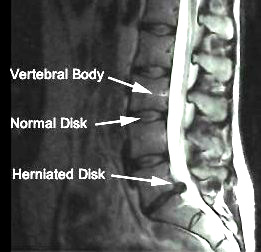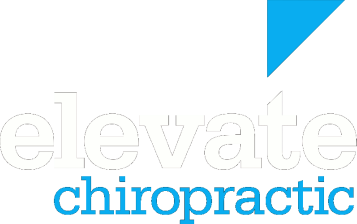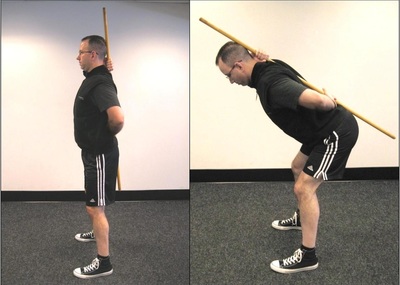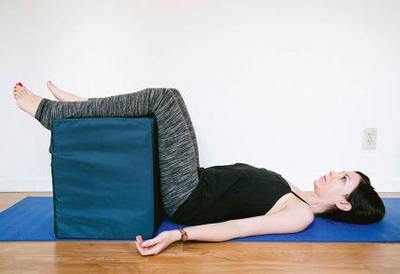
The diagnosis of a disc injury usually comes about by the search for an answer to some sort of back pain. From a chiropractic point of view, I see them regularly when people present with lower back pain. We take a history describing the problem. This includes things like; when did it start, how did it start, what makes it better/worse, any radiation into the limbs etc. We would then assess the area and do any testing that is required. This includes muscle strength testing, neurological testing, range of motion, joint function and so on. After all of this, diagnostic imaging can be used as way to back up what we found. The only true way to identify an actual disc bulge is via a scan such as an MRI (The image to the right shows an MRI of the lower back). It is important to remember, if you start looking for a problem with scans etc, you will often find them, and just because you see a disc bulge it does not mean that it is the cause of the problem. That is why you need to be careful with what treatment option you go for. Based on all of this investigation we will have a pretty good idea of what could be causing the problem and then you can look at what treatment options are available.
There are 3 key things to be aware of with a disc injury:
- Having a disc injury does not necessarily mean pain.
- Diagnostic testing, such as scans, does not always identify the source of the pain.
- The severity of a disc bulge does not correlate with the level of pain if it is present.
Treatment of a disc injury
This is the biggest question to ask, so I have back pain that may be due to a disc injury, what can I do to fix it? This is a hard question to answer as everyone is different with how they present. My approach is always to try the natural non-invasive options first. These include chiropractic care, rehabilitation and appropriate exercises. The second option is the more invasive approaches such as injections and surgery (I will not go into these in too much detail). Often the pain will ease with the appropriate non-invasive care so this is always a good place to start. If there are no improvements then you can head down the other path. Some common treatments include:
- Chiropractic care
- Physiotherapy
- Heat treatment
- Pain relief
- Movement advice to help reduce aggravation.
- An appropriate exercise program to help strengthen the area.
- Steroid injections.
- Surgery is an option as well. In my opinion this should be the last option.
How to help yourself
Chiropractic care
In the case of a disc injury, chiropractic care can help restore optimal function to the area. Chiropractic care will also help improve the communication between the body and brain and the brains response to this information (somatosensory integration). Various chiropractic techniques are available. Which technique is best will depend on the individual. Make sure you discuss this with your chiropractor. Chiropractic care works great in conjunction with appropriate stability and strength training.
Control the soft tissue component
This can be via the use of heat, massage etc. If there is significant muscular spasm and tightness, heat and massage is a good natural way of easing this. If you are wondering about the Ice Vs Heat debate, you can read a previous blog post of mine on this topic here and here.
Avoiding aggravation of the problem through good movement
In a lot of cases with these type of injuries, it has been years of poor movement and posture that has led to the problem. If you are sore, here is what you can do to help:
- Make sure you use the correct lifting techniques. Use your legs and not your back when lifting.
- Get out of chairs and bed safely. Again, this is using your legs and not pushing off your legs to get up. When getting out of a chair, keep your back straight and push up through your feet (like getting out of a squat). When getting out of bed roll onto your side, push yourself up into a sitting position then stand up using your legs.
- Practice the hip-hinge movement. When bending over, keep the back strong and stable and hinge through your hips. It has been found that repetitive hinging through your lower back (like most people do these days) is that fastest way to damage discs. I will discuss this movement in detail in another post. You can look on you tube at ‘hip hinge’ and you will see lots of videos describing how to do this. The picture on the left below shows what the hip hinge looks like using a stick o ensure good form.
- Avoid twisting whilst under load. This simply means, if you are carrying something, don’t twist your lower back. Keep it nice and stable and you will avoid aggravation of the injury.
- Try the ‘static back’ position. This is an Egoscue exercise, but has also been called the 90-90 position. It is a nice restful position that takes a lot of the pressure off of the lower back. Simply lay on your back on the ground with your legs up on a chair. Make sure your hips and knees are both at 90 degrees (see the picture on the right below). Most people find this position very comfortable. Try it and see what you think.
I said in part 1 that a common cause of a disc injury is a poor functioning spine with a lack of muscular support and stability. Hopefully you will consider chiropractic care to improve the spinal function, but then you need to work on the stability of the area. This is most easily done with appropriate spinal stability exercises. These stability exercises can be done safely without aggravation of the area. Make sure you have a good trainer that can teach you properly. If you want some advice on these, please ask.
Improve your movement patterns
Once again the hip-hinge motion is good here. Yoga and Pilates will also help with this. You can also try something like foundation training (www.foundationtraining.com) which is a great way of strengthening the lower back whilst improving your movement and stretching the right areas. I love this training. It has worked well on me.
There you have several ways to help ease the discomfort that can be associated with a disc injury. Try them or at least look into them and see what you think. If you would like a chiropractic assessment or any additional information, please feel free to contact me.
That is the end of my 2 part series on disc injuries and some simple ways to help. Hopefully you have found this information useful and can put some of it into use. In fact, a lot of these tips are useful for everyone, not just back pain sufferers. As I have said many times before, prevention is better than cure. Your body will thank you for it.
If you think someone you know may benefit from this information please share it with them or pass it on.





 RSS Feed
RSS Feed


